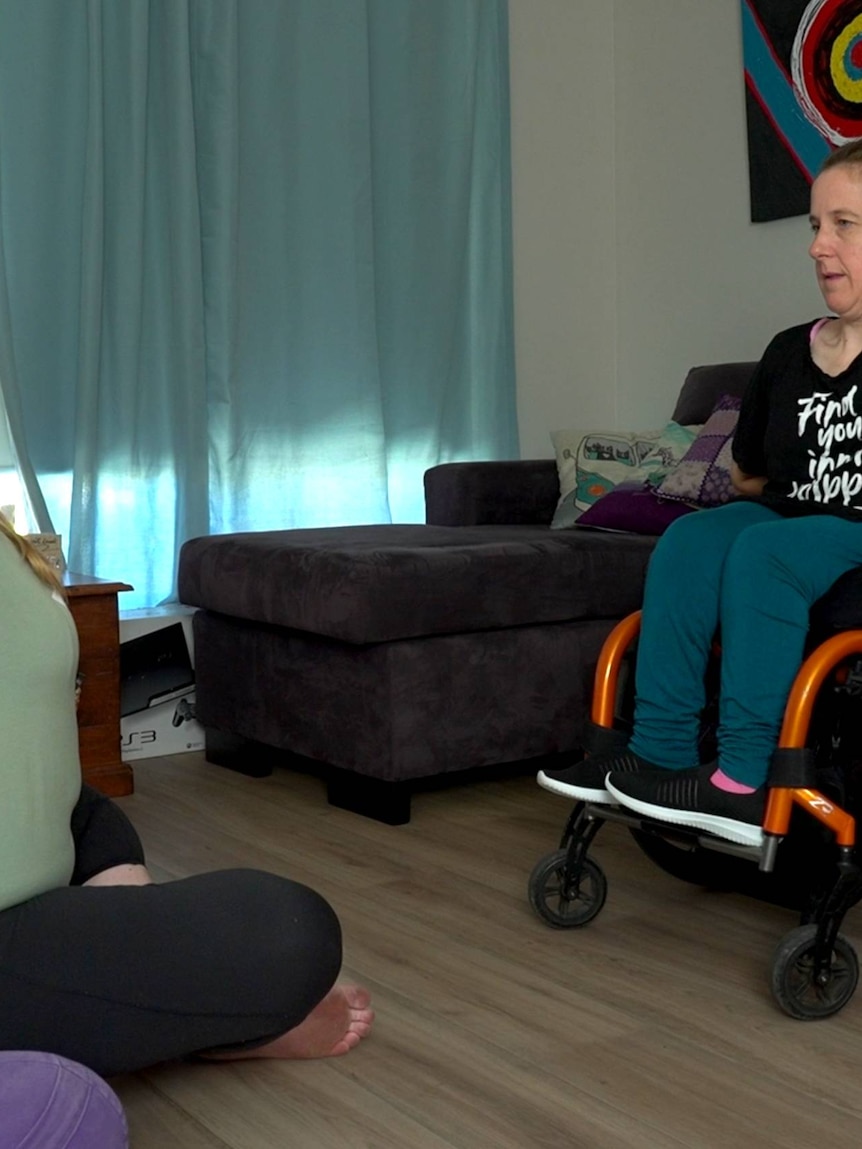For four years, yoga has helped Nick Schumi to get more movement in his body.
The popular practice is often promoted on social media, but that isn’t what attracted the Adelaide resident to it.
Instead, Mr Schumi — who has cerebral palsy — wanted a “yoga that worked for me”.
“Yoga doesn’t have to be about what you think it is, you know, doing a stretch in front of a waterfall ’cause it looks awesome,” he said.
“You see all those photos on social media … and that’s fantastic.
“But I didn’t see myself within that.”
Mr Schumi engages in a growing movement towards what is sometimes called “accessible and inclusive yoga”.
Participants also include Hanna Wilson, who has spina bifida — a condition that occurs when a baby’s spine and spinal cord do not develop properly during pregnancy.
“Yoga seems to be the thing that definitely works for me now, rather than going to the gym,” she said.
In Mr Schumi’s case, the effect has been transformative – yoga has enabled him to perform tasks that some wouldn’t think twice about.
“Part of my journey of doing yoga was even the process of getting from my wheelchair and getting to the floor,” he said.
“Getting up off the floor is a good functional thing that everybody should have the ability to do.
“The yoga has allowed me to build that skill and also be safer as somebody who lives on their own.”
Mr Schumi works with accessible and inclusive yoga instructor Sharmaine-Cherie Koszka, who visits clients with disabilities in their homes.
“We’re all designed differently and different things happen to people over the course of their lives,” she said.
“If they’re more comfortable on the floor, we work on the floor. If they’re better getting in and out of their chair onto the sofa, we work with the sofa.
“You can do beautiful twists in a chair, you can actually do some really strong yoga.”
‘Accessible for everybody’
Ms Koszka said the practice of inclusive yoga was gaining recognition as an option for people with disabilities.
“Whether you’re in a wheelchair or you’re able to sit in a regular chair, chair yoga makes yoga accessible for everybody,” she said.
“So we adapt yoga, we modify yoga to what suits them and their needs and their body.”
University of Adelaide lecturer Nicole Prideaux, who specialises in neurological physiotherapy, said the broader subject of mind-body therapies was “under-researched”, but she wants that to change.
“It would be a valuable space to increase research opportunities and look at what outcomes people can achieve,” she said.
Ms Prideaux is currently studying the effectiveness of yoga as a therapy for people who have had strokes.
“We do know that there can be improvements in things like balance, as well as independence, things around gait and mobility, also mood and things like depression and anxiety,” she said.
“People can participate both in a group and in a one-to-one setting [and] there’s not enough research at the moment to work out which would be better.”
Ms Koszka said her field was not without its critics, and “can be controversial in that people might look at us and say, ‘You’re not qualified to do that’,” she said.
“We’re not medical, I don’t claim to be a medical doctor.”
But she agreed with Ms Prideaux that “there should be some more research”, including around “accessibility to all sorts of yoga”.
“It would then make it more acceptable in the public eye, in a way – that yoga can be done in a seat just as equally as it can be done … on a mat,” she said.
In terms of achieving that public acceptance, South Australia trails other states, Ms Koszka said.
“In Victoria and New South Wales particularly chair yoga is very well known and very well received … [but] in Adelaide it seems to be a little more slow,” she said.
“[Some] studio owners say, ‘Yes, we’re adaptable, we’re accommodating’, and then my clients have rocked up there in their wheelchair, and to get to the yoga studio there are four flights of stairs.”
Social benefits as well as physical, participants say
Hanna Wilson also works with Ms Koszka, and said she found that yoga provided relief from constant shoulder and neck issues.
“I got in my first wheelchair when I was about five, I believe – a tiny little pink wheelchair,” Ms Wilson said.
“I do most of my stuff on my couch, so I’m either seated on the couch or laying down. We do a lot of stretch poses.”
Ms Wilson, who has also battled breast cancer, said she “found that yoga has really, really helped” with her mobility and “severe fatigue”.
Ms Wilson said that she was working with Ms Koszka to organise a group for people who have or have had breast cancer for a “meditation-type session, maybe by the water”.
It’s practices like that, its supporters say, that highlight yoga’s potential to deliver social, as well as mental and physical, outcomes.
“I live quite a busy life,” Mr Schumi said.
“Yoga has allowed me to relax into my body.”




